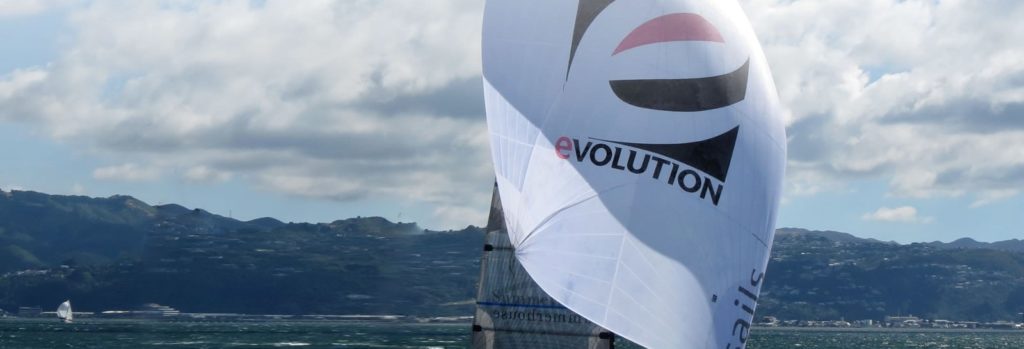By: Andy Camarda
The marvel of modern sail cloths means that sails no longer die a premature death due to structural failures. Instead, the majority of sails are used until the shape is no longer suitable for use. Racers and cruisers have different criteria for considering a sail blown out, but the overall concept is the same.
A note about shape
The two concepts we are going to look most closely at are the overall depth of a sail and the draft position, especially how it relates to entry and exit angles. Depth is measured as the overall distance between the sail at the deepest point and an imaginary straight line from the luff to leech. A deeper sail is going to create more power at the expense of drag (which we see as heel among other things), while a flatter sail is going to create less power and less drag.
The draft position where the maximum depth of the sail is fore and aft is generally expressed as a percentage. For example, a well-designed racing jib will have its draft position 30-35% of the way from the luff of the sail to the leech. Genoas tend to be around 35% and mainsails will be even a touch further aft than that.

Draft position is more about hitting an ideal location than changing characteristics like maximum depth. When the draft position is off, a sail can become inefficient or hard to maneuver. A draft that is too far forward will create a sail that is hard to steer with a narrow groove. A draft that is too far aft will create a sail that is draggy and inefficient, causing heel and lacking the ability to sail close to the wind.
Entry and exit angles are a combination of maximum depth and draft. Sails with a wider entry angle (coming more from the side of the boat) will create sails with a wider groove and more power at the expense of pointing and efficiency. Sails with a narrow entry angle (coming more from the front) will have a narrower groove but can be more efficient. Generally, sails built for lighter air and all-purpose sailing will have a wider entry angle to keep the boat moving. Heavier air sails have a narrower entry angle and are easier to keep the boat up to speed; this also helps with efficiency and the importance of heel control.
Exit angles are a bit simpler in that we generally want a nice clean exit off the back of the sail with minimal hook to weather. Again, lighter air and more all-purpose sails will have a wider exit angle due to their deeper shape, but the differences are not as profound as the entry angles. When a sail has too much exit angle or starts cupping in the leech, it starts to create excess drag which creates more heel and slows the boat down. In more extreme cases, this changes how tight a sail can be trimmed to prevent too much drag being created from a tighter trim angle
Sails are always stretching
Sails stretch or deform under load the entire time they are flying. Even a brand-new, carbon membrane sail will see some deformation while flying. Designers work with this initial stretch to create the ideal flying shape, anticipating how the wind will actually see the sail. Sails start to accumulate that stretch and over time, you will see the overall shape of the sail change and start moving away from the ideal shape the designer intended. Let’s take a bit of a deeper dive into what that looks like.
As a sail stretches and ages, three main things happen. Two are related so we will handle them together. The sail will become deeper, and the draft will move aft in the sail. Together, these will cause a sail to lose efficiency, pointing ability, and will generally cause the boat to heel more without gaining more forward speed. This means depowering earlier.
The combination of the depth and maximum draft position moving creates a fine entry angle. As the entry angle gets too fine for the use of the sail, the groove will become narrower. This makes the sail harder to drive to, the trim will require more attention, and it causes the boat to lose speed more often.
The last issue that the accumulated deformation causes to a sail is curling in the leech commonly referred to as cupping. This is caused both by the draft and depth wandering aft in the sail and due to localized stretch in the leech of the sail. The cupping is generally made worse by the flapping of the leech due to insufficient leech line tension. Proper leech tension is especially important on sails with no battens like genoas and roller furling mains.
When the leech of the sail begins to cup and create a wide entry angle, the sail becomes draggy which costs speed. The cupping causes turbulent flow off the back of the sail; this creates bigger issues with headsails as that turbulent wind will flow back into the mainsail, basically giving it bad air from within the boat.
A knock-on effect of accumulated stretch is a difference in how it effects a sail from top to bottom. At the foot of the sail, the forces tend to be more horizontal, stretching the sail from front to back. Higher up in the sail, the forces tend to be more vertical as the sheet loads are pulling down as much as back. The difference in the loading patterns is most apparent on higher aspect sails like modern jibs. The difference in loading causes the foot of the sail to flatten out and move the draft more aft, while the middle and top of the sail tend to gain depth more quickly as it ages. This makes an older sail harder to trim as its generally ideal to have a consistent depth and draft position from top to bottom.



